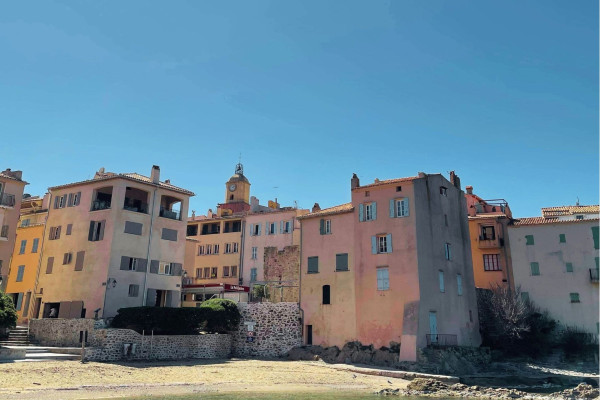Who is behind the winemaker of the Gulf of Saint-Tropez ans what does he/she do?
The winemaker is much more than a wine producer but who is he really? Who is behind the label and who makes the magic happen ? He is a craftsman, a farmer and sometimes an artist. Their role goes far beyond simply growing vines: they oversee every stage of production, from winter pruning to ageing in the cellar.
The skills required are many: an understanding of the soils, a mastery of winemaking techniques, and a good dose of patience. Because working in the vineyard is above all a question of time.
A profession at the heart of nature and conviviality
Being a winemaker means working in symbiosis with nature and offering moments of sharing through each bottle. This profession, which is often family-run, is also a real bridge between the terroir and wine lovers around the world.
A job of passion marked by the seasons
In the common imagination, the profession of winemaker conjures up images of sunny vineyards, cellars full of precious wines and a great passion for vines and wine. However, behind this dream image lies a difficult job, guided by the seasons and the whims of nature. Let’s dive into the fascinating world of these artisans of the land and find out what their daily lives are like.

Key moments in the wine year
WINTER : TIME FOR VINIFICATION AND CARING FOR THE VINES
Although the vineyards may seem to be asleep, this season is far from a time of rest for the winemaker. It’s during this period that strategic decisions are taken, directly influencing the quality and quantity of the future harvest. It’s also a quieter time for us, when the winemakers are likely to take a few days’ well-deserved rest. They are also keeping in touch with the local association that will help them to plant, prepare and know more about the evolution of their job like Syndicat des Côtes de Provence for us.
….. – Vine pruning :
Winter pruning is essential for guiding the growth of vine stocks. It determines the distribution of the bunches, their exposure to the sun and their sap supply. Proper pruning results in better-balanced, higher-quality grapes. In our vineyards, pruning is mainly carried out using the cordon de Royat or gobelet method, but there are also other styles, such as Guyot, depending on the regulations, the vine stock, the soil, the age of the vine and, of course, the goodwill of the winemaker !
….. – Floor preparation :
During the winter, the soil is worked to prepare it for the next crop. Sometimes sheep come to graze, providing natural fertiliser, compacting the soil with their paws and also giving a very bucolic feel to our vineyards. This stage of the work is essential to optimise rooting, manage weeds and improve soil structure. This is also the time when we pull out any vines that are too old or diseased.
….. – The bottling process :
The first bottles are about to see the light of day, and rosé wines can be bottled and sold here from 1 December (Côtes de Provence AOP decree). Before then, the bottles, labels and corks have to be carefully selected for this long-awaited moment. If the winery is large enough, it will usually have its own machine on the estate, but if not, it will call in a bottling truck. It’s a large lorry where, by the magic of pipes and pumps, the wine is bottled on the estate. Appointments should be made well in advance, as these trucks are overloaded with work.

SPRING : TIME TO PREPARE FOR THE COMING HARVEST
After a winter’s rest, the vines come back to life with the appearance of the first buds. This is also a season to be vigilant, as climatic risks such as frost or disease can compromise the harvest before it has even begun.
….. – Budburst :
This stage marks the awakening of the vine, when the buds swell and open to make way for the first shoots. Each bud represents the promise of a harvest. Disbudding, i.e. the removal of certain buds, is necessary to concentrate the vine’s energy in the remaining buds.
….. – The first diseases :
With humidity and rising temperatures, diseases such as mildew and powdery mildew can appear, requiring increased surveillance. In our area, we are particularly vigilant because our proximity to the sea and our 300 days of sunshine a year (do we need to remind you?) favour the appearance of mildew.
Spring also sees the planting of new vines, which will require patience and protection (against frost, wild boar and rabbits….). These vines are sometimes surrounded to prevent damage and can be watered to ensure better growth.

SUMMER : THE HARVEST BEGINS
Summer marks the culmination of a whole year’s work. The long-awaited harvest requires unfailing organisation and special care to ensure that the quality of the grapes is preserved right through to the vat. At the beginning of the summer, the blossom forms, a very special moment that also indicates a potential harvest date: around 100 days later, the harvest can begin.
….. – The harvest :
Before the long-awaited harvest, the green harvest may take place, when a few bunches are removed from each vine to concentrate the energy in the remaining ones. Once optimum ripeness has been reached, each grape variety and each plot is harvested. This decision is based on precise analyses and tastings of the berries. In our vineyards, this is done mainly at night and by machine.
….. – Vinification :
Once harvested, the grapes go into the cellar to begin their transformation into wine. This stage is generally managed by the oenologist, but sometimes the winemaker and the oenologist work as one, as is the case on most family estates.
….. – Key stages :
Destemming (separating the grapes from the stalks) either carried out directly on the vine when the harvest is done by machine, or in the cellar if it is done by hand.
Pressing of the grapes: before fermentation for white and rosé wines, generally after fermentation for reds.
Fermentation (transformation of sugar into alcohol) to turn the grape juice into wine.

AUTUMN : A TIME OF REST FOR THE VINES AND ACTIVITY IN THE CELLARS
Autumn is a time for resting and caring for the vines. Having given so much, it’s time to take care of it. It’s also the start of a new phase for winemakers (or oenologists): maturing the wine in the cellar and preparing the vines for the next cycle.
….. – Vinification and ageing in the cellar :
Once the grapes have been harvested and vinified, the juice begins its transformation into wine. This process requires rigorous monitoring, as every detail can influence the final result. In Provence, we are considered to have a very precise technique when it comes to blending. In fact, each estate or château has a direct link with a consultant oenologist who helps them to refine their blends, to get an outside opinion and to offer you the best. They are also helped by the Centre du Rosé which is a unique center in the world dedicated to analysing, studying and making tests for the future of rosé.
….. – Soil management :
The winemakers work lightly to loosen the soil after the machines have passed through, sometimes sowing green manure. This is also the time for the horses to come and plough the land to aerate it before winter sowing.
….. – Preparation for pruning :
The tools are checked and maintained so that they’re ready when winter arrives.

So now that you know who is behind the winemaker job. You might understand more that this job is above all a vocation that combines passion and rigour. It’s a challenging job, but one that also brings great satisfaction. By following the seasons, we explored the many facets of this profession and what makes its unique charm. The winemaker has work to do all year round and is a bit of a jack-of-all-trades. Follow us on our social networks to find out more about the daily lives of winegrowers and their well-kept secrets !


























